Research on Determining Elastic–Plastic Constitutive Parameters of Materials from Load Depth Curves Based on Nanoindentation Technology
Abstract
1. Introduction
2. Identification Procedure
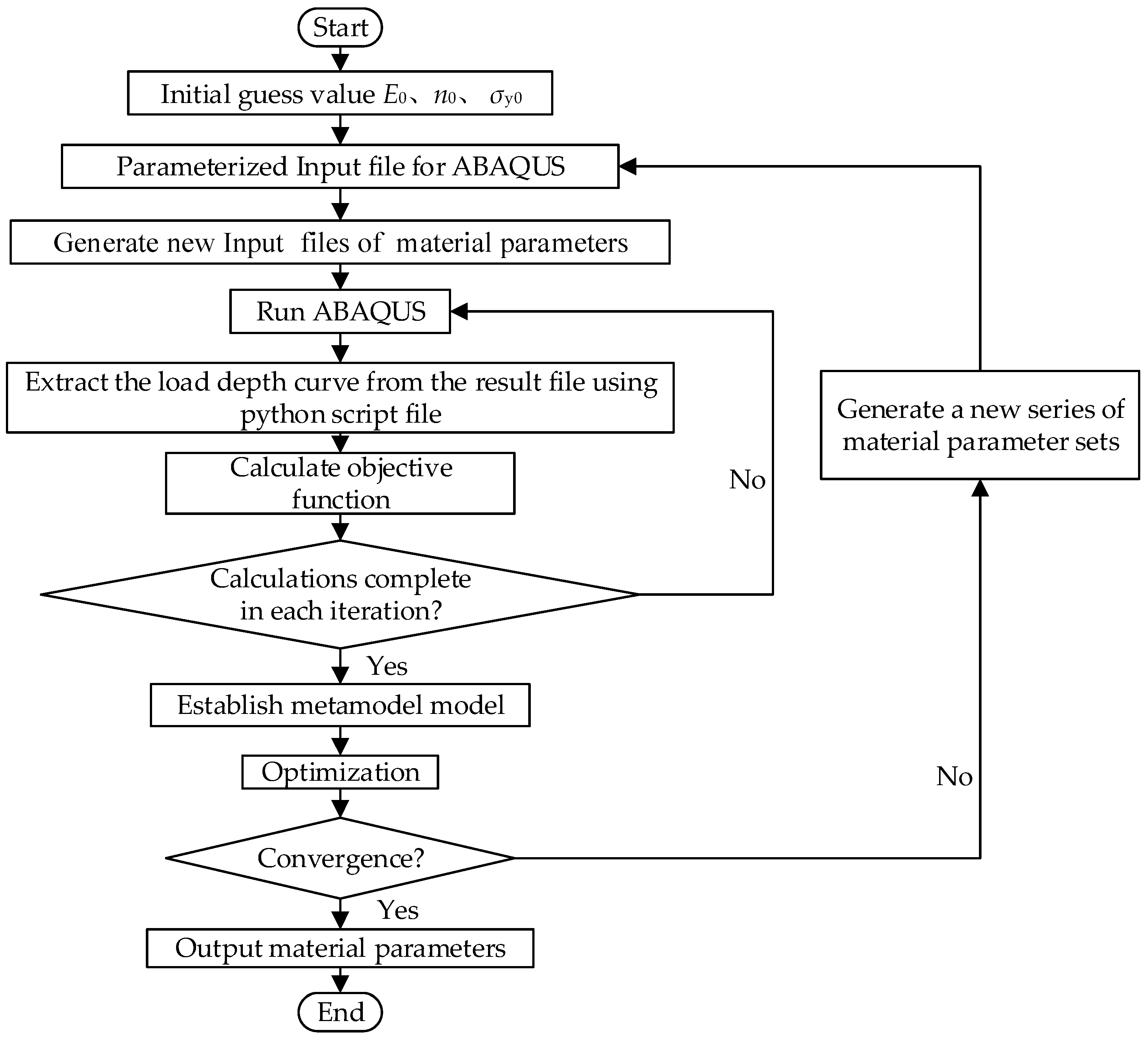
3. Numerical Study
3.1. Finite Element Simulation
3.2. DOE Analysis
3.3. Study of the Uniqueness of the Solution
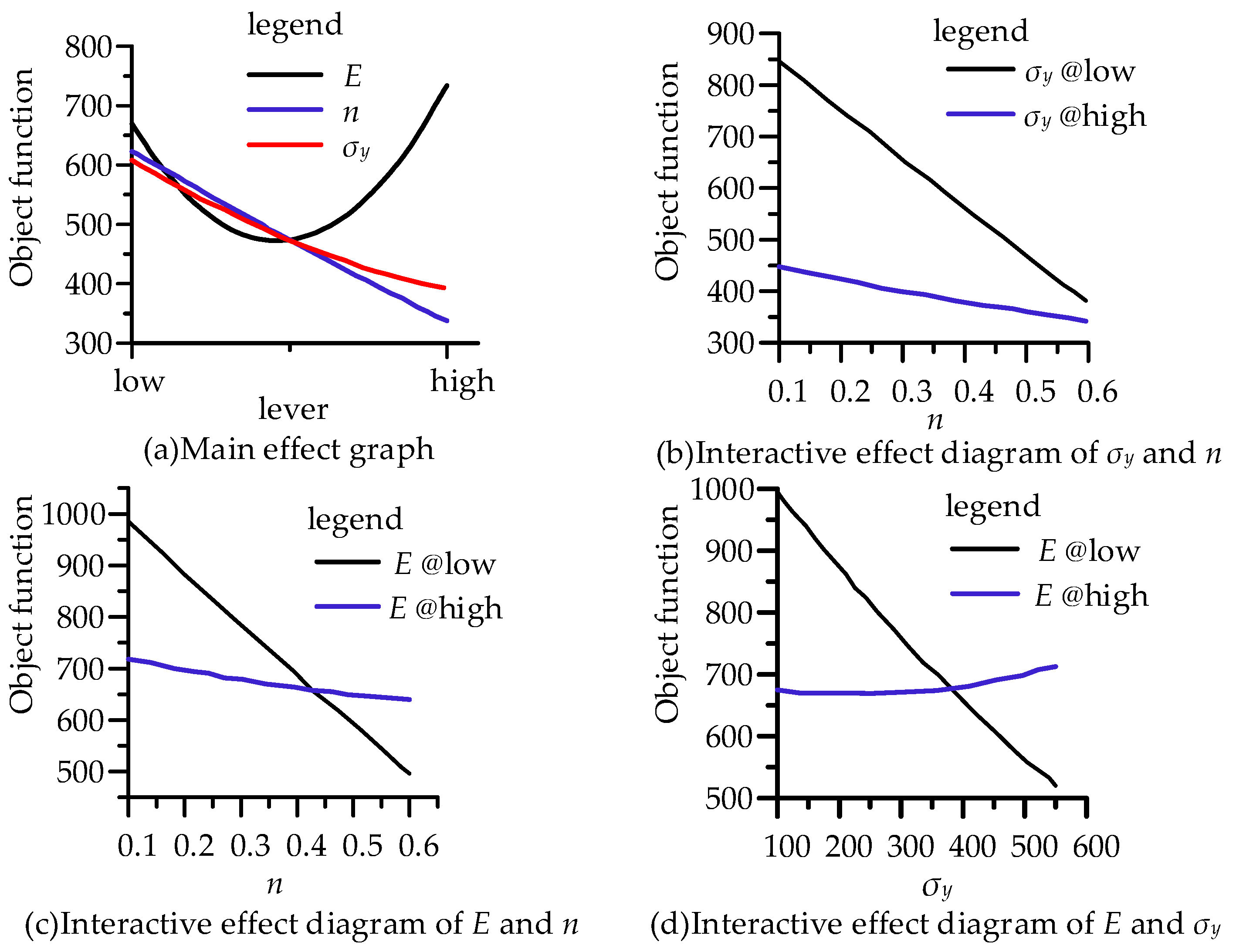
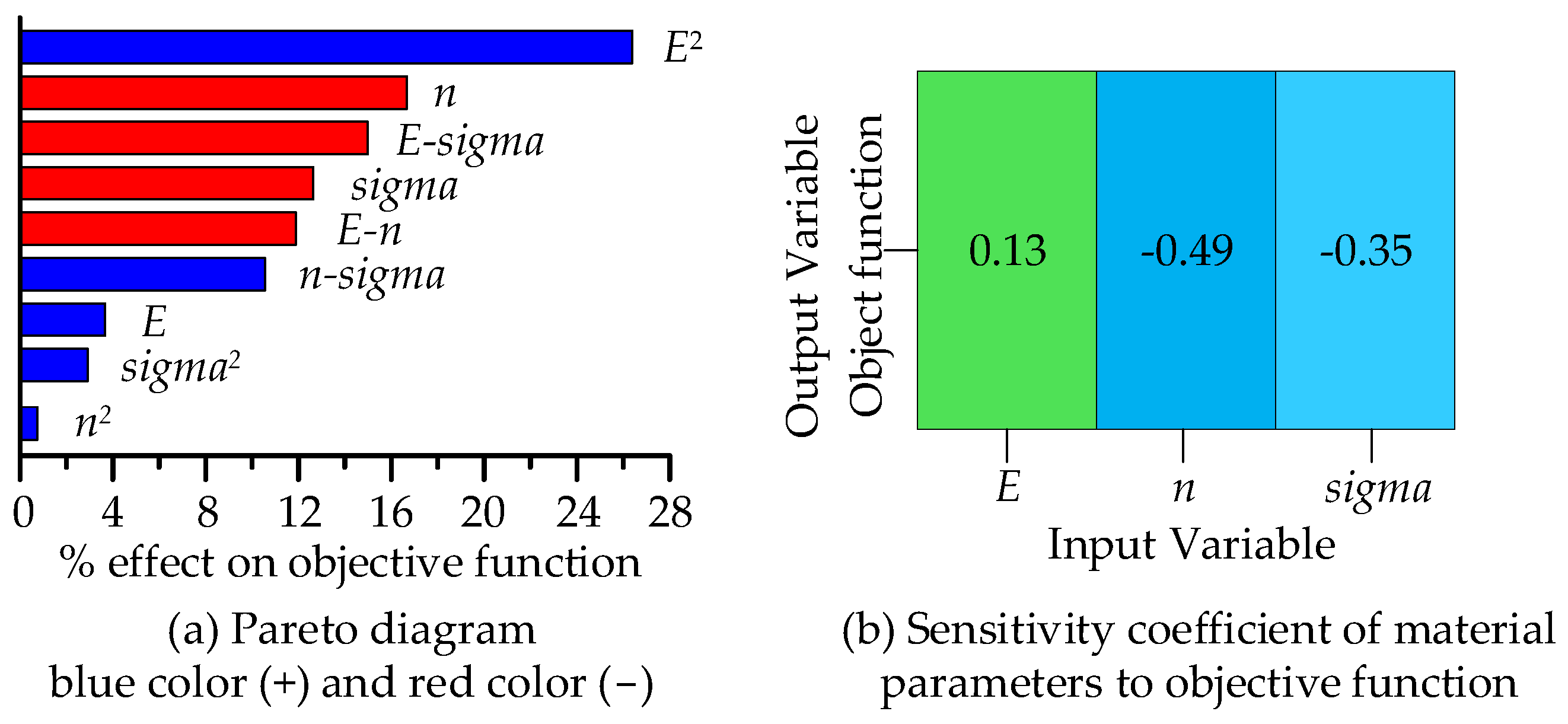
| E0 (GPa) | n0 | σy0 (MPa) | |
|---|---|---|---|
| T1 | 50 | 0.2 | 80 |
| T2 | 90 | 0.5 | 120 |
| T3 | 120 | 0.8 | 200 |
| Boundaries | 20 < E < 150 | 0.01 < n < 1 | 30 < σy < 600 |
4. Experimental Validation
4.1. Sample Preparation
4.2. Mechanical Test
4.3. Comparations and Results
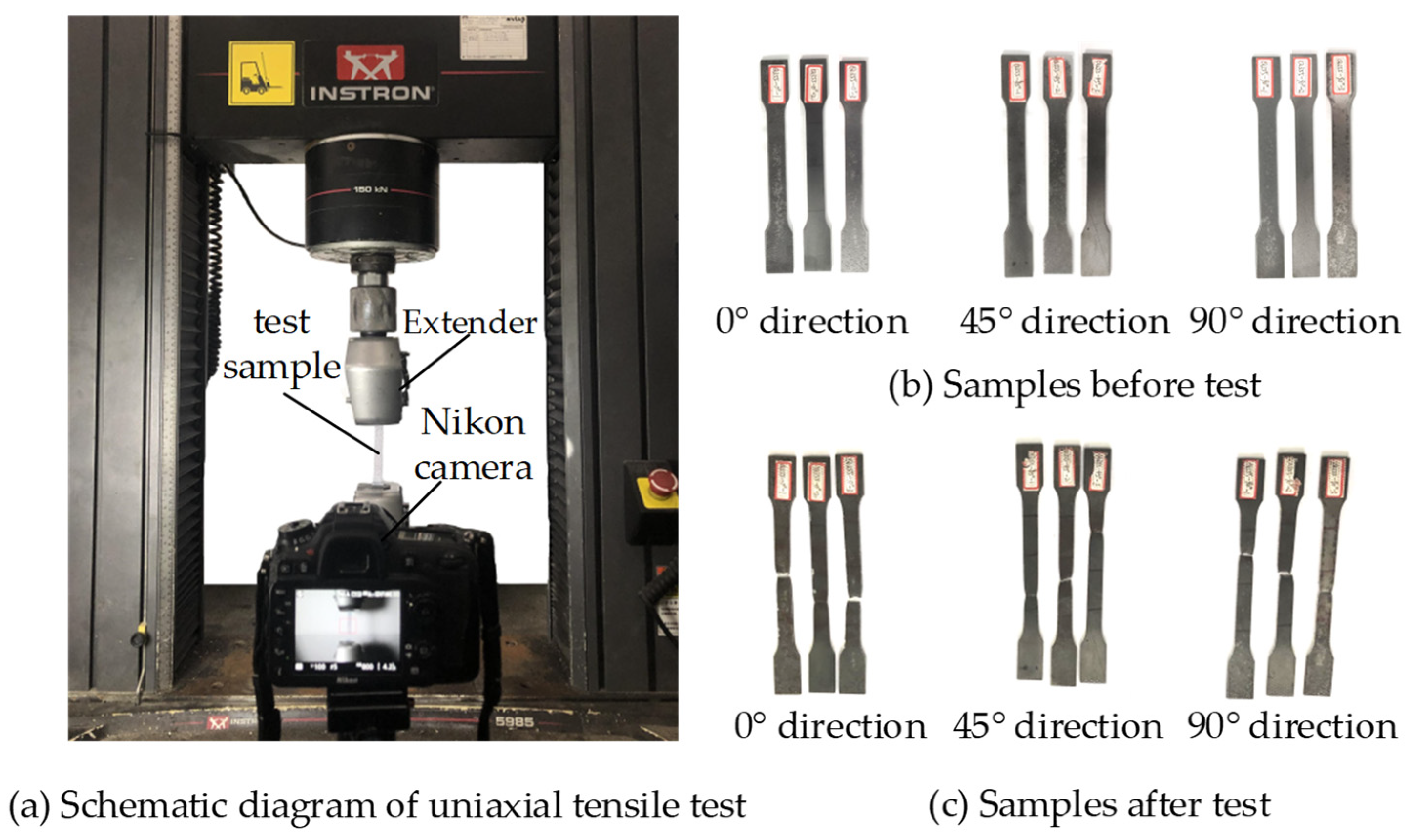
5. Discussion
6. Conclusions
Author Contributions
Funding
Data Availability Statement
Acknowledgments
Conflicts of Interest
Appendix A. Latin Hypercube Design Matrix of Material Parameters
| Number | E (MPa) | n | σy (MPa) | Number | E (MPa) | n | σy (MPa) |
|---|---|---|---|---|---|---|---|
| 1 | 294,081.633 | 0.294 | 292.860 | 26 | 146,122.449 | 0.518 | 155.100 |
| 2 | 199,387.755 | 0.437 | 467.350 | 27 | 163,877.551 | 0.304 | 504.080 |
| 3 | 234,897.959 | 0.386 | 338.780 | 28 | 21,836.735 | 0.447 | 366.330 |
| 4 | 175,714.286 | 0.508 | 338.780 | 29 | 98,775.510 | 0.457 | 274.490 |
| 5 | 205,306.122 | 0.222 | 100.000 | 30 | 57,346.939 | 0.549 | 145.920 |
| 6 | 81,020.408 | 0.355 | 550.000 | 31 | 157,959.184 | 0.171 | 320.410 |
| 7 | 63,265.306 | 0.314 | 302.040 | 32 | 104,693.878 | 0.243 | 412.240 |
| 8 | 217,142.857 | 0.253 | 403.060 | 33 | 10,000.000 | 0.202 | 357.140 |
| 9 | 122,448.980 | 0.600 | 265.310 | 34 | 163,877.551 | 0.365 | 109.180 |
| 10 | 193,469.388 | 0.416 | 228.570 | 35 | 92,857.143 | 0.559 | 393.880 |
| 11 | 252,653.061 | 0.141 | 311.220 | 36 | 69,183.673 | 0.151 | 246.940 |
| 12 | 128,367.347 | 0.284 | 201.020 | 37 | 33,673.469 | 0.569 | 283.670 |
| 13 | 45,510.204 | 0.488 | 494.900 | 38 | 110,612.245 | 0.161 | 118.370 |
| 14 | 187,551.020 | 0.590 | 458.160 | 39 | 264,489.796 | 0.529 | 522.450 |
| 15 | 15,918.367 | 0.427 | 210.200 | 40 | 181,632.653 | 0.120 | 191.840 |
| 16 | 288,163.265 | 0.467 | 256.120 | 41 | 223,061.224 | 0.580 | 219.390 |
| 17 | 58,571.429 | 0.539 | 375.510 | 42 | 39,591.837 | 0.273 | 173.470 |
| 18 | 27,755.102 | 0.324 | 439.800 | 43 | 51,428.571 | 0.192 | 513.270 |
| 19 | 228,979.592 | 0.110 | 448.980 | 44 | 75,102.041 | 0.100 | 384.690 |
| 20 | 270,408.163 | 0.345 | 164.290 | 45 | 276,326.531 | 0.182 | 182.650 |
| 21 | 86,938.776 | 0.396 | 136.730 | 46 | 211,224.490 | 0.263 | 237.760 |
| 22 | 134,285.714 | 0.498 | 540.820 | 47 | 282,244.898 | 0.365 | 476.530 |
| 23 | 116,530.612 | 0.406 | 430.610 | 48 | 300,000.000 | 0.212 | 421.430 |
| 24 | 246,734.694 | 0.233 | 531.630 | 49 | 140,204.082 | 0.131 | 485.710 |
| 25 | 152,040.816 | 0.335 | 329.590 | 50 | 240,816.327 | 0.478 | 127.550 |
Appendix B. Inversion Results of Parameters with Different Loading Times
| Loading Times | E (GPa) | Error (%) | n | Error (%) | σy (MPa) | Error (%) |
|---|---|---|---|---|---|---|
| 1 | 211.547 | 0.737 | 0.100 | 28.618 | 403.518 | 5.910 |
| 5 | 207.215 | 1.326 | 0.111 | 20.435 | 398.457 | 4.582 |
| 10 | 210.089 | 0.042 | 0.143 | 2.235 | 380.354 | 0.170 |

References
- Kang, J.J.; Becker, A.A.; Wen, W.; Sun, W. Extracting elastic-plastic properties from experimental loading-unloading indentation curves using different optimization techniques. Int. J. Mech. Sci. 2018, 144, 102–109. [Google Scholar] [CrossRef]
- Goto, K.; Watanabe, I.; Ohmura, T. Determining suitable parameters for inverse estimation of plastic properties based on indentation marks. Int. J. Plast. 2019, 116, 81–90. [Google Scholar] [CrossRef]
- Chen, H.; Cai, L.X.; Bao, C. Equivalent-energy indentation method to predict the tensile properties of light alloys. Mater. Des. 2018, 362, 322–330. [Google Scholar] [CrossRef]
- Sun, M.C.; Yang, C.; Xiao, S.Y.; Tan, W.; Zhou, G.P. Analysis of the mechanical properties of Q345R steel in deep-regulating units by the spherical indentation method. IOP Conf. Ser. Mater. Sci. Eng. 2019, 668, 012017. [Google Scholar] [CrossRef]
- Chen, H.; Cai, L.X.; Li, C. An elastic-plastic indentation model for different geometric indenters and its applications. Mater. Today Commun. 2020, 25, 101440. [Google Scholar] [CrossRef]
- Ruiz-Moreno, A.; Hähner, P.; Fumagalli, F.; Haiblikova, V.; Conte, M.; Randall, N. Stressstrain curves and derived mechanical parameters of P91 steel from spherical nanoindentation at a range of temperatures. Mater. Des. 2020, 194, 108950. [Google Scholar] [CrossRef]
- Chudoba, T.; Schwarzer, N.; Richter, F. Determination of elastic properties of thin films by indentation measurements with a spherical indenter. Surf. Coat Tech. 2000, 127, 9–17. [Google Scholar] [CrossRef]
- Moy, C.K.S.; Bocciarelli, M.; Ringer, S.P.; Ranzi, G. Indentation and imprint mapping for the identification of material properties in multi-layered systems. Comp. Mater. Sci. 2011, 50, 1681–1691. [Google Scholar] [CrossRef]
- Wen, W.; Becker, A.A.; Sun, W. Determination of material properties of thin films and coatings using indentation tests: A review. J. Mater. Sci. 2017, 52, 12553–12573. [Google Scholar] [CrossRef]
- Boughton, O.R.; Ma, S.C.; Zhao, S.; Arnold, M.; Lewis, A.; Hansen, U.; Cobb, J.P.; Giuliani, F.; Abel, R.L. Measuring bone stiffness using spherical indentation. PLoS ONE 2018, 13, e0200475. [Google Scholar] [CrossRef]
- Boughton, O.R.; Ma, S.C.; Cai, X.R.; Yan, L.Y.; Peralta, L.; Laugier, P.; Marrow, J.; Giuliani, F.; Hansen, U.; Abel, R.L.; et al. Computed tomography porosity and spherical indentation for determining cortical bone millimetre-scale mechanical properties. Sci. Rep. 2019, 9, 7416. [Google Scholar] [CrossRef] [PubMed]
- Vachhani, S.J.; Kalidindi, S.R.; Burr, T.; Pathak, S. Lamellar Level Correlations between Mechanical Behavior and Composition in Mouse Bone. JOM 2021, 73, 3034–3045. [Google Scholar] [CrossRef]
- Oliver, W.C.; Pharr, G.M. An improved technique for determining hardness and elastic modulus using load and displacement sensing indentation experiments. J. Mater. Res. 1992, 7, 1564–1583. [Google Scholar] [CrossRef]
- Oliver, W.C.; Pharr, G.M. Measurement of hardness and elastic modulus by instrumented indentation: Advances in understanding and refinements to methodology. J. Mater. Res. 2004, 19, 3–20. [Google Scholar] [CrossRef]
- Hertz, H. Miscellaneous Papers; Macmillan: New York, NY, USA, 1896. [Google Scholar]
- Pharr, G.M.; Oliver, W.C.; Brotzen, F.R. On the generality of the relationship among contact stiffness, contact area, and elastic modulus during indentation. J. Mater. Res. 1992, 7, 613–617. [Google Scholar] [CrossRef]
- Hernot, X.; Bartier, O.; Bekouche, Y.; El Abdi, R.; Mauvoisin, G. Influence of penetration depth and mechanical properties on contact radius determination for spherical indentation. Int. J. Solids Struct. 2006, 43, 4136–4153. [Google Scholar] [CrossRef]
- Bec, S.; Tonck, A.; Georges, J.M.; Georges, E.; Loubet, J.L. Improvements in the indentation method with a surface force apparatus. Philos. Mag. A 1996, 74, 1061–1072. [Google Scholar] [CrossRef]
- Hsueh, C.-H.; Miranda, P. Combined empirical–analytical method for determining contact radius and indenter displacement during Hertzian indentation on coating/substrate systems. J. Mater. Res. 2004, 19, 2774–2781. [Google Scholar] [CrossRef]
- Cheng, Y.-T.; Cheng, C.-M. Can stress–strain relationships be obtained from indentation curves using conical and pyramidal indenters. J. Mater. Res. 1999, 14, 3493–3496. [Google Scholar] [CrossRef]
- Chollacoop, N.; Ramamurty, U. Robustness of the algorithms for extracting plastic properties from the instrumented sharp indentation data. Mater. Sci. Eng. A 2006, 423, 41–45. [Google Scholar] [CrossRef]
- Moy, C.K.S.; Bocciarelli, M.; Ringer, S.P.; Ranzi, G. Identification of the material properties of Al 2024 alloy by means of inverse analysis and indentation tests. Mater. Sci. Eng. A 2011, 529, 119–130. [Google Scholar] [CrossRef]
- Tho, K.K.; Swaddiwudhipong, S.; Liu, Z.S.; Zeng, K.; Hua, J. Uniqueness of reverse analysis from conical indentation tests. J. Mater. Res. 2011, 19, 2498–2502. [Google Scholar] [CrossRef]
- Cheng, Y.T.; Cheng, C.M. Scaling, dimensional analysis, and indentation measurements. Mat. Sci. Eng. R 2004, 44, 91–149. [Google Scholar] [CrossRef]
- Futakawa, M.; Wakui, T.; Tanabe, Y.; Ioka, I. Identification of the constitutive equation by the indentation technique using plural indenters with different apex angles. J. Mater. Res. 2001, 16, 2283–2292. [Google Scholar] [CrossRef]
- Cheng, Y.T.; Li, Z.Y.; Cheng, C.M. Scaling, relationships for indentation measurements. Philos. Mag. A 2002, 82, 1821–1829. [Google Scholar] [CrossRef]
- Swaddiwudhipong, S.; Tho, K.K.; Liu, Z.S.; Zeng, K. Material characterization based on dual indenters. Int. J. Solids Struct. 2005, 42, 69–83. [Google Scholar] [CrossRef]
- Nakamura, T.; Gu, Y. Identification of elastic-plastic anisotropic parameters using instrumented indentation and inverse analysis. Mech. Mater. 2007, 39, 340–356. [Google Scholar] [CrossRef]
- Chen, X.; Ogasawara, N.; Zhao, M.; Chiba, N. On the uniqueness of measuring elastoplastic properties from indentation: The indistinguishable mystical materials. J. Mech. Phys. Solids 2007, 55, 1618–1660. [Google Scholar] [CrossRef]
- Tabor, D. The hardness and strength of metals. J. Inst. Metals 1951, 79, 1. [Google Scholar]
- Chollacoop, N.; Dao, M.; Suresh, S. Depth-sensing instrumented indentation with dual sharp indenters. Acta Mater. 2003, 51, 3713–3729. [Google Scholar] [CrossRef]
- Zhao, M.H.; Ogasawara, N.; Chiba, N.; Chen, X. A new approach to measure the elastic-plastic properties of bulk materials using spherical indentation. Acta Mater. 2006, 54, 23–32. [Google Scholar] [CrossRef]
- Yonezu, A.; Yoneda, K.; Hirakata, H.; Sakihara, M.; Minoshima, K. A simple method to evaluate anisotropic plastic properties based on dimensionless function of single spherical indentation—Application to SiC whisker-reinforced aluminum alloy. Mater. Sci. Eng. A 2010, 527, 7646–7657. [Google Scholar] [CrossRef]
- Kang, J.J.; Becker, A.A.; Sun, W. A combined dimensional analysis and optimization approach for determining elastic-plastic properties from indentation tests. J. Strain. Anal. Eng. 2011, 46, 749–759. [Google Scholar] [CrossRef]
- Ogasawara, N.; Chiba, N.; Chen, X. Representative strain of indentation analysis. J. Mater. Res. 2005, 20, 2225–2234. [Google Scholar] [CrossRef]
- Luo, J.; Lin, J.; Dean, T.A. A study on the determination of mechanical properties of a power law material by its indentation force-depth curve. Philos. Mag. A 2006, 86, 2881–2905. [Google Scholar] [CrossRef]
- Khan, M.K.; Hainsworth, S.V.; Fitzpatrick, M.E.; Edwards, L. A combined experimental and finite element approach for determining mechanical properties of aluminium alloys by nanoindentation. Comp. Mater. Sci. 2010, 49, 751–760. [Google Scholar] [CrossRef]
- Sun, G.Y.; Wang, E.D.; Zhao, T.; Zheng, G.; Li, Q. Inverse identification of cell-wall material properties of closed-cell aluminum foams based upon Vickers nano-indentation tests. Int. J. Mech. Sci. 2020, 176, 105524. [Google Scholar] [CrossRef]
- Fan, Z.; Rho, J.Y.; Swadener, J.G. Three-dimensional finite element analysis of the effects of anisotropy on bone mechanical properties measured by nanoindentation. J. Mater. Res. 2004, 19, 114–123. [Google Scholar] [CrossRef]
- Mullins, L.R.; Bruzzi, M.S.; McHugh, P.E. Calibration of a constitutive model for the post-yield behaviour of cortical bone. J. Mech. Behav. Biomed. 2009, 2, 460–470. [Google Scholar] [CrossRef]
- Schwiedrzik, J.J.; Zysset, P.K. Quantitative analysis of imprint shape and its relation to mechanical properties measured by microindentation in bone. J. Biomech. 2015, 48, 210–216. [Google Scholar] [CrossRef]
- Field, J.S.; Swain, M.V. Determining the mechanical properties of small volumes of material from submicrometer spherical indentations. J. Mater. Res. 1995, 10, 101–112. [Google Scholar] [CrossRef]
- Taljat, B.; Zacharia, T.; Kosel, F. New analytical procedure to determine stress-strain curve from spherical indentation data. Int. J. Solids Struct. 1998, 35, 4411–4426. [Google Scholar] [CrossRef]
- Nayebi, A.; El Abdi, R.; Bartier, O.; Mauvoisin, G. New procedure to determine steel mechanical parameters from the spherical indentation technique. Mech. Mater. 2002, 34, 243–254. [Google Scholar] [CrossRef]
- Collin, J.-M.; Mauvoisin, G.; Pilvin, P.; ElAbdi, R. Use of spherical indentation data changes to materials characterization based on a new multiple cyclic loading protocol. Mater. Sci. Eng. A 2008, 488, 608–622. [Google Scholar] [CrossRef]
- Feng, C.; Kang, B.S. Young’s Modulus Measurement Using a Simplified Transparent Indenter Measurement Technique. Exp. Mech. 2008, 48, 9–15. [Google Scholar] [CrossRef]
- Feng, C.; Tannenbaum, J.M.; Kang, B.S.; Alvin, M.A. A Load-Based Multiple-Partial Unloading Micro-Indentation Technique for Mechanical Property Evaluation. Exp. Mech. 2010, 50, 737–743. [Google Scholar] [CrossRef]
- Kim, K.H.; Kim, Y.C.; Jeon, E.C.; Kwon, D. Evaluation of indentation tensile properties of Ti alloys by considering plastic constraint effect. Mater. Sci. Eng. A 2011, 528, 5259–5263. [Google Scholar] [CrossRef]
- Huang, L.Y.; Guan, K.S.; Xu, T.; Zhang, J.M.; Wang, Q.Q. Investigation of the mechanical properties of steel using instrumented indentation test with simulated annealing particle swarm optimization. Theor. Appl. Fract. Mech. 2019, 102, 116–121. [Google Scholar] [CrossRef]
- Mirjalili, S. Genetic Algorithm. In Evolutionary Algorithms and Neural Networks: Theory and Applications; Mirjalili, S., Ed.; Springer International Publishing: Cham, Switzerland, 2019; pp. 43–55. [Google Scholar]
- Katoch, S.; Chauhan, S.S.; Kumar, V. A review on genetic algorithm: Past, present, and future. Multimed. Tools Appl. 2021, 80, 8091–8126. [Google Scholar] [CrossRef]
- Li, M.; Li, G.; Azarm, S. A kriging metamodel assisted multi-objective genetic algorithm for design optimization. J. Mech. Des. 2008, 130, 031401. [Google Scholar] [CrossRef]
- Kleijnen, J.P.C. Kriging metamodeling in simulation: A review. Eur. J. Oper. Res. 2009, 192, 707–716. [Google Scholar] [CrossRef]
- Tyurin, A.I.; Victorov, S.D.; Kochanov, A.N.; Shuklinov, A.V.; Pirozhkova, T.S. Methods of Micro- and Nanoindentation for Characterization of Local Physical and Mechanical Properties of Multiphase Materials. In Proceedings of the AIP Conference Proceedings, Tomsk, Russia, 19–23 September 2016; Volume 1783. [Google Scholar] [CrossRef]
- Remache, D.; Semaan, M.; Rossi, J.M.; Pithioux, M.; Milan, J.L. Application of the Johnson-Cook plasticity model in the finite element simulations of the nanoindentation of the cortical bone. J. Mech. Behav. Biomed. 2020, 101, 103426. [Google Scholar] [CrossRef] [PubMed]
- Lee, H.; Lee, J.H.; Pharr, G.M. A numerical approach to spherical indentation techniques for material property evaluation. J. Mech. Phys. Solids 2005, 53, 2037–2069. [Google Scholar] [CrossRef]
- Lee, J.H.; Kim, T.; Lee, H. A study on robust indentation techniques to evaluate elastic–plastic properties of metals. Int. J. Solids Struct. 2010, 47, 647–664. [Google Scholar] [CrossRef]
- Jiang, P.; Zhang, T.; Yang, R. Experimental verification for an instrumented spherical indentation technique in determining mechanical properties of metallic materials. J. Mater. Res. 2011, 26, 1414–1420. [Google Scholar] [CrossRef]
- Li, C.J.; Liu, K.; Wang, H.R.; Li, L.; Xue, T. Study on Determination of Mechanical Properties of Metal by Indentation Test. In Proceedings of the 2020 IEEE 4th Information Technology, Networking, Electronic and Automation Control Conference (Itnec 2020), Chongqing, China, 12–14 June 2020; pp. 1961–1965. [Google Scholar]


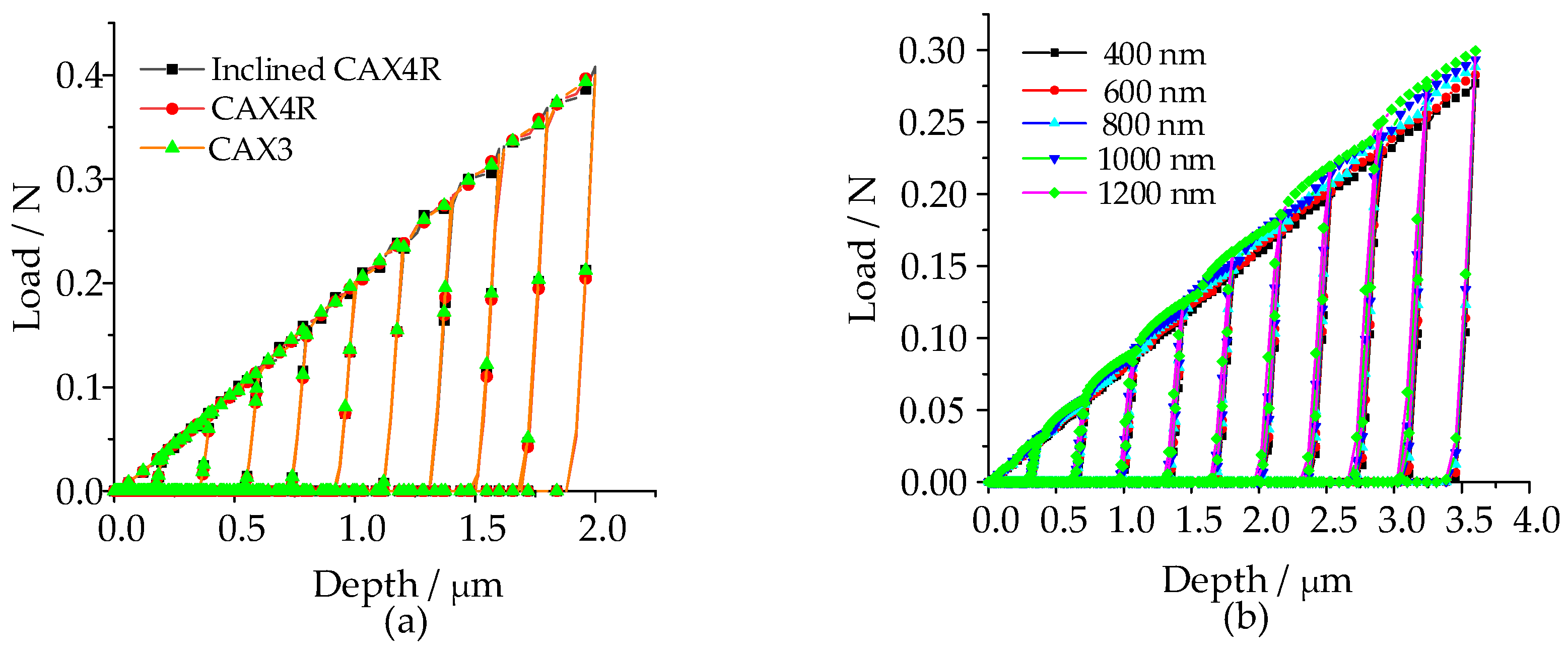

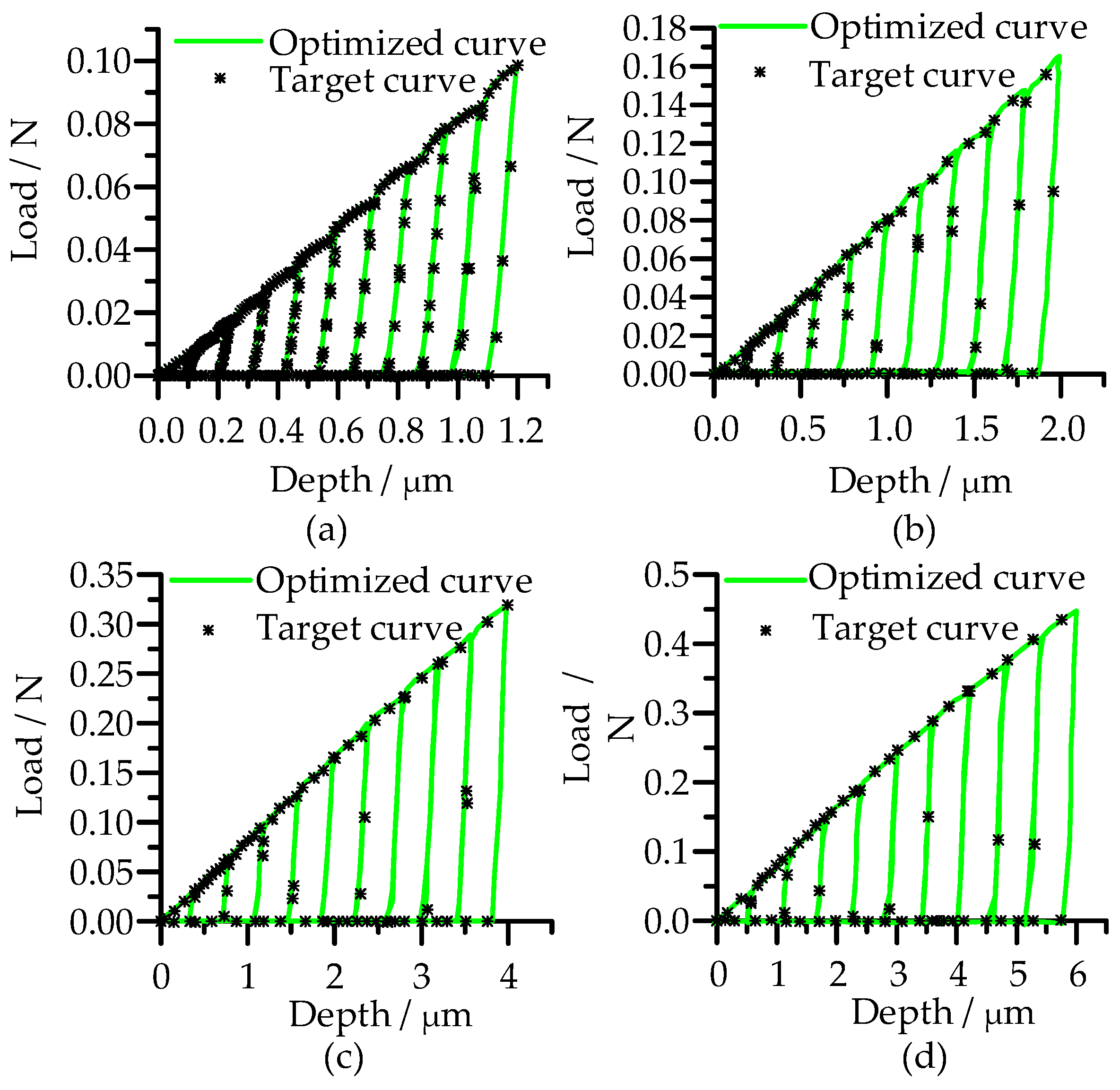
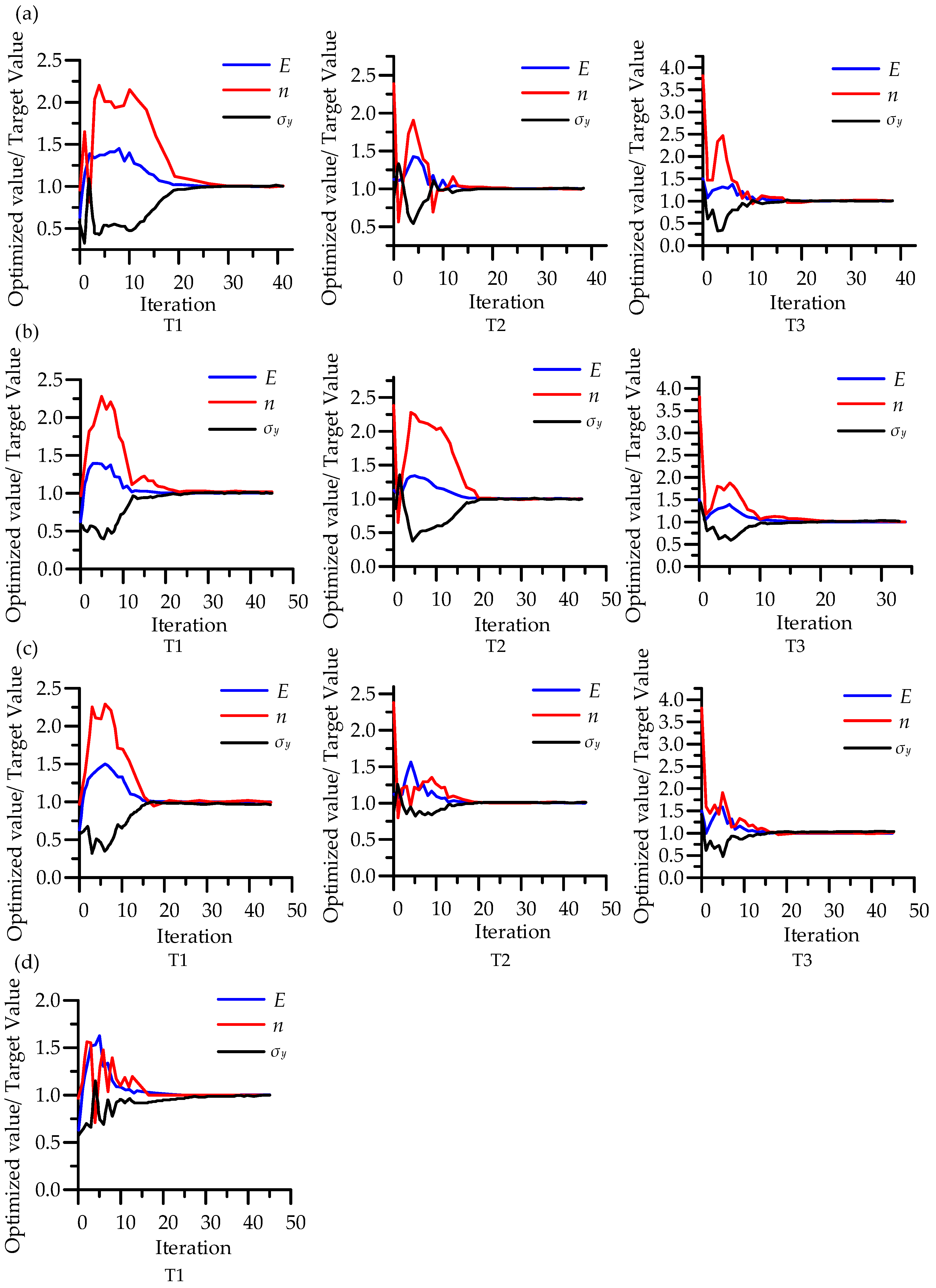

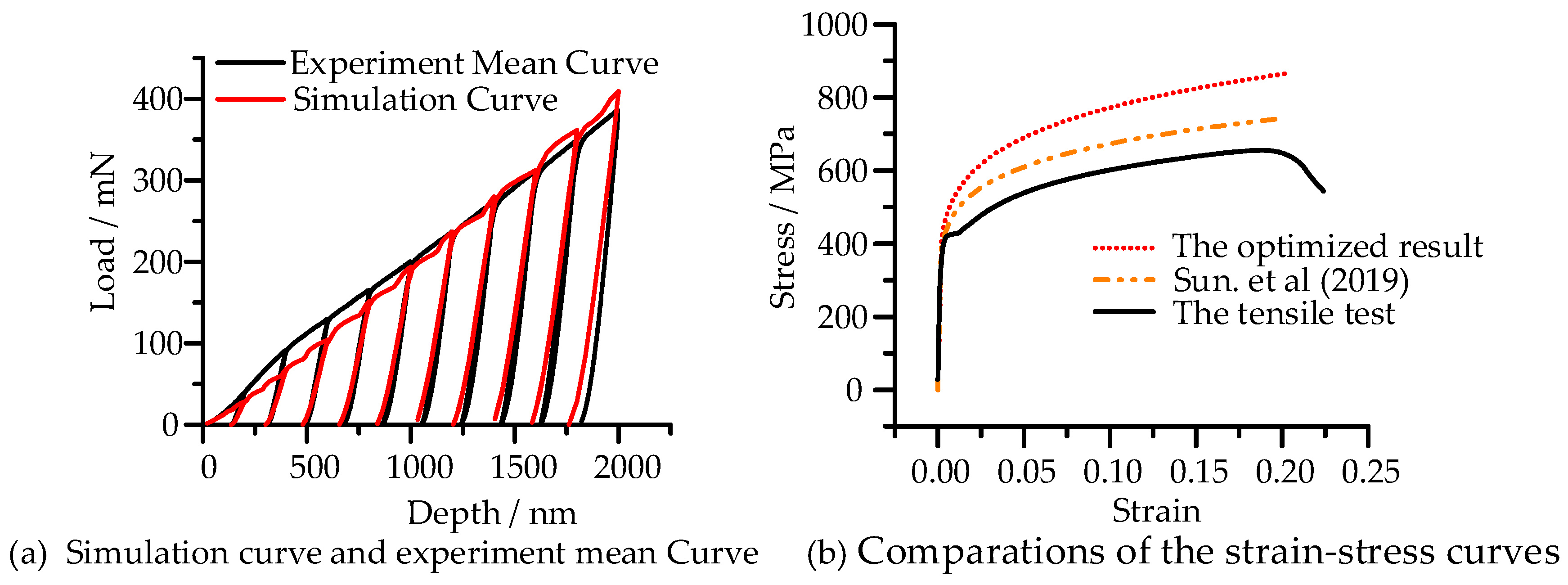
| hmax | Test | E (GPa) | Error (%) | n | Error (%) | σy (MPa) | Error (%) |
|---|---|---|---|---|---|---|---|
| 1200 nm | T1 | 80.0010 | 0.00125 | 0.210026 | 0.01238 | 139.99400 | 0.00429 |
| T2 | 80.0009 | 0.00112 | 0.210022 | 0.01048 | 139.99500 | 0.00357 | |
| T3 | 80.0001 | 0.00013 | 0.209998 | 0.00095 | 140.00100 | 0.00071 | |
| 2000 nm | T1 | 80.0074 | 0.00925 | 0.210284 | 0.13524 | 139.93700 | 0.04500 |
| T2 | 79.9991 | 0.00112 | 0.209971 | 0.01381 | 140.00700 | 0.00500 | |
| T3 | 79.9990 | 0.00125 | 0.209993 | 0.00333 | 140.00200 | 0.00143 | |
| 4000 nm | T1 | 79.9836 | 0.02050 | 0.209773 | 0.10810 | 140.05800 | 0.04143 |
| T2 | 79.9942 | 0.00725 | 0.209912 | 0.04190 | 140.02200 | 0.01571 | |
| T3 | 79.9821 | 0.02237 | 0.209741 | 0.12333 | 140.06600 | 0.04714 | |
| 6000 nm | T1 | 80.1152 | 0.14400 | 0.212645 | 1.25952 | 139.36300 | 0.45500 |
| Variable Name | Initial Value | Lower Bound | Upper Bound | Optimized Value |
|---|---|---|---|---|
| E (GPa) | 210 | 189 | 231 | 189.000 |
| n | 0.2 | 0.1 | 0.3 | 0.162 |
| σy (GPa) | 350 | 300 | 500 | 416.071 |
Disclaimer/Publisher’s Note: The statements, opinions and data contained in all publications are solely those of the individual author(s) and contributor(s) and not of MDPI and/or the editor(s). MDPI and/or the editor(s) disclaim responsibility for any injury to people or property resulting from any ideas, methods, instructions or products referred to in the content. |
© 2023 by the authors. Licensee MDPI, Basel, Switzerland. This article is an open access article distributed under the terms and conditions of the Creative Commons Attribution (CC BY) license (https://creativecommons.org/licenses/by/4.0/).
Share and Cite
Li, Z.; Ye, Y.; Zhang, G.; Guan, F.; Luo, J.; Wang, P.; Zhao, J.; Zhao, L. Research on Determining Elastic–Plastic Constitutive Parameters of Materials from Load Depth Curves Based on Nanoindentation Technology. Micromachines 2023, 14, 1051. https://doi.org/10.3390/mi14051051
Li Z, Ye Y, Zhang G, Guan F, Luo J, Wang P, Zhao J, Zhao L. Research on Determining Elastic–Plastic Constitutive Parameters of Materials from Load Depth Curves Based on Nanoindentation Technology. Micromachines. 2023; 14(5):1051. https://doi.org/10.3390/mi14051051
Chicago/Turabian StyleLi, Zhentao, Yun Ye, Guanjun Zhang, Fengjiao Guan, Junjie Luo, Panfeng Wang, Jiao Zhao, and Li Zhao. 2023. "Research on Determining Elastic–Plastic Constitutive Parameters of Materials from Load Depth Curves Based on Nanoindentation Technology" Micromachines 14, no. 5: 1051. https://doi.org/10.3390/mi14051051
APA StyleLi, Z., Ye, Y., Zhang, G., Guan, F., Luo, J., Wang, P., Zhao, J., & Zhao, L. (2023). Research on Determining Elastic–Plastic Constitutive Parameters of Materials from Load Depth Curves Based on Nanoindentation Technology. Micromachines, 14(5), 1051. https://doi.org/10.3390/mi14051051






